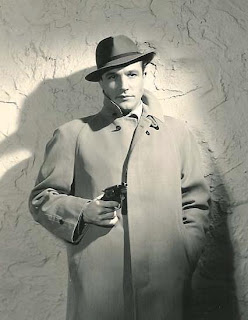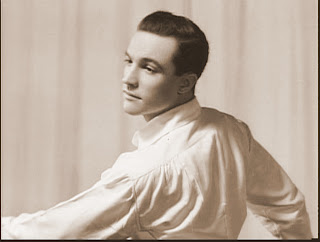 Deanna Durbin and Gene Kelly as Abigail Martin and Robert Manette in "Christmas Holiday" (1944) directed by Robert Siodmak. With script by Herman J. Mankiewicz ("Dinner at Eight", "The Pride of the Yankees", "Citizen Kane") based on W. Somerset Maugham's novel.
Deanna Durbin and Gene Kelly as Abigail Martin and Robert Manette in "Christmas Holiday" (1944) directed by Robert Siodmak. With script by Herman J. Mankiewicz ("Dinner at Eight", "The Pride of the Yankees", "Citizen Kane") based on W. Somerset Maugham's novel. "Kelly’s grin here becomes the Devil’s, he comes home with blood-stained trousers and finally materializes to "straighten out the family"; Durbin first sees him at a recital of Liebestod and then performs "Always" to celebrate their union. "I guess maybe there’s another meaning to love than what I was taught," Harens says after hearing the tale. Melodic noir, and unsettling delirium -- the ripely masochistic former child-star and the stubbly, grounded dancer face each other in the shadows, and Siodmak wonders how America got to this point. (Hitchcock similarly reimagines Robert Walker in 'Strangers on a Train')." Source: www.cinepassion.org
"Kelly’s grin here becomes the Devil’s, he comes home with blood-stained trousers and finally materializes to "straighten out the family"; Durbin first sees him at a recital of Liebestod and then performs "Always" to celebrate their union. "I guess maybe there’s another meaning to love than what I was taught," Harens says after hearing the tale. Melodic noir, and unsettling delirium -- the ripely masochistic former child-star and the stubbly, grounded dancer face each other in the shadows, and Siodmak wonders how America got to this point. (Hitchcock similarly reimagines Robert Walker in 'Strangers on a Train')." Source: www.cinepassion.org "Starring in the role of the homme fatal and also playing against type is the master of acrobatic dance, Gene Kelly. That said, in an obvious tongue in cheek move there is a scene in which Kelly asks Durbin to dance. Precisely upon the point of arriving on the dance floor the band concludes the number and the dance never comes off". Source: www.noiroftheweek.com
"Starring in the role of the homme fatal and also playing against type is the master of acrobatic dance, Gene Kelly. That said, in an obvious tongue in cheek move there is a scene in which Kelly asks Durbin to dance. Precisely upon the point of arriving on the dance floor the band concludes the number and the dance never comes off". Source: www.noiroftheweek.com Vera-Ellen and Gene Kelly in "Words and Music" (1948) directed by Norman Taurog
Vera-Ellen and Gene Kelly in "Words and Music" (1948) directed by Norman Taurog "Set in a sleazy New York neighborhood, Kelly's Dancer encounters the wonderful Vera-Ellen as The Blonde. The couple dance seductively, and their mutual interest seems to grow as the music changes to a breezy, cheerful melody. Together they enter a saloon that seems to be populated by the city's finest gangsters and prostitutes. The music grows jazzy...the couple is smitten with each other. Vera-Ellen is the epitome of sensuality with her short skirt and seductive manner. Gene is equally seductive in what could possibly be his sexiest outfit as he dances a very masculine "ballet" to win the girl over". Source: genescene.blogspot.com
"Set in a sleazy New York neighborhood, Kelly's Dancer encounters the wonderful Vera-Ellen as The Blonde. The couple dance seductively, and their mutual interest seems to grow as the music changes to a breezy, cheerful melody. Together they enter a saloon that seems to be populated by the city's finest gangsters and prostitutes. The music grows jazzy...the couple is smitten with each other. Vera-Ellen is the epitome of sensuality with her short skirt and seductive manner. Gene is equally seductive in what could possibly be his sexiest outfit as he dances a very masculine "ballet" to win the girl over". Source: genescene.blogspot.comVera-Ellen and Gene Kelly performing in the tragic ballet "Slaughter On Tenth Avenue" composed by Richard Rodgers from the 1948 movie "Words and Music".
 As she struts in under the Tenth Avenue she attracts the attention of a local thug (played by choreographer/dancer Jack Baker) who makes a crude pass at her. Quickly we learn her interest in focused on Gene Kelly's tenement flat. Kelly, at his most muscular and athletic, rises from bed and climbs down to the street where Vera is strutting, preening and slithering around him, even rubbing herself up against a phallic pole. It is a mating call and Kelly takes the bait. Once again she moves away from him, but they finally end their teasing courtship and come together in a sensuous dance as he dips and drags her body along the street.
As she struts in under the Tenth Avenue she attracts the attention of a local thug (played by choreographer/dancer Jack Baker) who makes a crude pass at her. Quickly we learn her interest in focused on Gene Kelly's tenement flat. Kelly, at his most muscular and athletic, rises from bed and climbs down to the street where Vera is strutting, preening and slithering around him, even rubbing herself up against a phallic pole. It is a mating call and Kelly takes the bait. Once again she moves away from him, but they finally end their teasing courtship and come together in a sensuous dance as he dips and drags her body along the street. Vera-Ellen: This dance not only changed my career, it changed me. From Gene Kelly I learned the modern knee drops, slides, and the earthy, almost brutal, approach to rhythm. Gene and me worked ten weeks on the number and when I was through with it I was also a different person; my walk changed and I even switched from a flower-scented perfume to something called 'Shameless'. Gene really influenced my life. For my money, he's just about the greatest in the business.
Vera-Ellen: This dance not only changed my career, it changed me. From Gene Kelly I learned the modern knee drops, slides, and the earthy, almost brutal, approach to rhythm. Gene and me worked ten weeks on the number and when I was through with it I was also a different person; my walk changed and I even switched from a flower-scented perfume to something called 'Shameless'. Gene really influenced my life. For my money, he's just about the greatest in the business. Staged by Gene Kelly, the "Slaughter On Tenth Avenue" number was serious, different from Ray Bolger's slaphappy dance routine. It has been termed the first "dance noir", echoing the popular film noir genre of the '40s.
Staged by Gene Kelly, the "Slaughter On Tenth Avenue" number was serious, different from Ray Bolger's slaphappy dance routine. It has been termed the first "dance noir", echoing the popular film noir genre of the '40s.
 Vera Ellen went on to work with Gene Kelly again in the classic 'On the Town' (1949) directed by Stanley Donen and Gene Kelly.
Vera Ellen went on to work with Gene Kelly again in the classic 'On the Town' (1949) directed by Stanley Donen and Gene Kelly. Gabey (Gene Kelly) and Ivy (Vera-Ellen) discuss where they should meet in the film "On the Town":
Gabey (Gene Kelly) and Ivy (Vera-Ellen) discuss where they should meet in the film "On the Town":Gabey: Top of the Empire State Building.
Ivy Smith: But it's so high up!
Gabey: Oh it won't seem high to me. I'm in the clouds right now.
 At the University of Arizona, once a year, there is a Vera-Ellen day in the "Art History of the Cinema" class, right there next to Alfred Hitchcock, Fred Astaire, Ginger Rogers and Gene Kelly. TCM, American Movie Classics and the American One network with their periodic revivals of classics such as 'Words and Music', 'Three Little Words', 'White Christmas', 'Happy Go Lovely', 'The Belle of New York' and 'On the Town' have made a whole new generation ask: "Who was that amazingly talented Vera-Ellen and what happened to her? -"Vera-Ellen: The Magic and the Mystery" by David Soren (2008)
At the University of Arizona, once a year, there is a Vera-Ellen day in the "Art History of the Cinema" class, right there next to Alfred Hitchcock, Fred Astaire, Ginger Rogers and Gene Kelly. TCM, American Movie Classics and the American One network with their periodic revivals of classics such as 'Words and Music', 'Three Little Words', 'White Christmas', 'Happy Go Lovely', 'The Belle of New York' and 'On the Town' have made a whole new generation ask: "Who was that amazingly talented Vera-Ellen and what happened to her? -"Vera-Ellen: The Magic and the Mystery" by David Soren (2008)This post belongs to the Noir Blogathon 2012 called by the Self-Styled Siren and Ferdy on Films.
Donations this year go to the Film Noir Foundation under the leadership of Eddie Muller, in order to restaurate and save classic noir films.
 I've already made a small donation. Please, donate to the Film Noir Foundation following this Paypal Donation Link. Thanks!
I've already made a small donation. Please, donate to the Film Noir Foundation following this Paypal Donation Link. Thanks!





















































